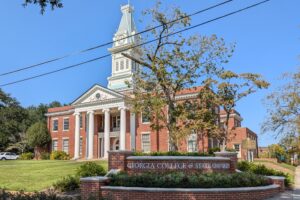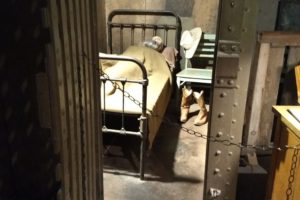When we first drove into Monument Valley and saw this lodge up against the mountain/hill, what came to my mind that someone has taken financial advantage of this area. Then we learned about the Gouldings (previous post). We love learning about people who change where they live for the good. Oh to be such people.

outside views





During WWI, Harry was part of the U.S. Army’s engineering company during WWI, so building the Trading Post and their apartment was easier for him than it would be for us.
trading post



The Gouldings sold staples the Navajos wanted: sugar, flour, coffee, tobacco, canned goods, and house wares. The Navajos used pawn such as silver jewelry or hand-woven rugs to buy what they wanted. When roads were built that allowed trucks to bring in products, convenient grocery stores diminished the importance of the Trading Post. Of course, Gouldings has provided a great grocery store just down the road from the lodge and dining room.
museum

The Navajos called Harry Tall Sheep. Their years in the area coincided with the period of time when the traditional people of the remote northwestern corner of the reservation first came to grips with the 20th century.
During this time the Navajos had to cope with these traumatic issues:
- Forced stock reduction
- Transition from barter and pawn to a cash economy
- Broadening experiences of WWII
- Secret mining of uranium before Hiroshima (remember Moki Dugway?) Word is now that the Navajos are bringing in drinking water because they believe their ground water is poisoning them because of the uranium.
- Struggle to improve education and medical facilities
- Emergence of democratic tribal government
- Development of arterial roads through the reservation
- The first Navajo Tribal Park in Monument Valley
And in the midst of all this change, John Ford headquartered his movie people and their equipment at Gouldings to film his westerns. As a nation we were growing, but we were also dragging others along with us who may not wanted to change. A real dilemma.
upstairs apartment





outside movie set

“She Wore a Yellow Ribbon.” The exterior shots were filmed here in 1946.



The potato cellar was constructed using some Anglo techniques and some Navajo techniques. The roof is supported with rough cut cedar logs that also are used for Navajo hogans. The roof is reinforced with wood slating and then a very thick dirt roof was applied. The sides are made of leftover sandstone blocks quarried for the trading Post building. The exterior door is the original.
For our sake, they’ve removed the vegetables and made the inside to look the way it did in the movie, but the produce was still inside when they filmed. Here’s what the inside looked like in the movie.



final view

and now a word from The Duke





